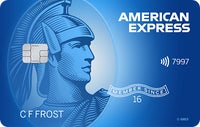Amex Blue Cash Preferred vs. Blue Cash Everyday

Key takeaways
- The Blue Cash Preferred® Card from American Express and the Blue Cash Everyday® Card from American Express both offer high cash back reward opportunities in a number of popular everyday categories, including at U.S. supermarkets and U.S. gas stations.
- While the Blue Cash Preferred offers higher rewards in categories like groceries, it also charges an annual fee. The Blue Cash Everyday charges no annual fee in exchange for reduced rewards.
- Both cards offer statement credit opportunities for certain purchases, but the credits differ, so you’ll need to decide which better suits your spending habits.
Blue Cash Preferred® Card from American Express and the Blue Cash Everyday® Card from American Express are two of the most popular cash back cards around. Choosing which card is best for you depends on many factors. For example, the Blue Cash Preferred charges an annual fee, whereas the Blue Cash Everyday does not, yet you’ll get a higher rewards rate with the Blue Cash Preferred.
Which top American Express credit card should you sign up for? That really depends, but here’s a comprehensive guide to help you decide:
Main details
| Blue Cash Preferred Card from American Express | Blue Cash Everyday Card from American Express | |
|---|---|---|
| Welcome bonus |
|
|
| Rewards rate |
|
|
| Intro APR | 0% intro APR on purchases and balance transfers for 12 months, followed by a 18.24%-29.24% Variable APR | 0% intro APR on purchases and balance transfers for 15 months, followed by a 18.24%-29.24% Variable APR |
| Annual fee | $0 intro annual fee for the first year, then $95. | $0 |
Blue Cash Preferred vs. Blue Cash Everyday highlights
This comparison guide can help you determine which card stands out in the categories you care about most.

Blue Cash Preferred
-
The Blue Cash Preferred offers a welcome bonus of $250 when you spend $3,000 on your new card within the first six months of account opening. Often, you only have three months to earn a welcome bonus, but this card doubles that timeframe. You need to spend an average of just $500 each month to earn the bonus.
The Blue Cash Everyday offers a slightly lower $200 statement credit welcome offer after you spend $2,000 in purchases on your new card within the first six months, so an average of just under $334 monthly.
Average monthly spend to earn welcome bonus Total spend in 6 months to earn welcome bonus Bonus statement credit Blue Cash Preferred $500 $3,000 $250 statement credit Blue Cash Everyday $334 $2,000 $200 statement credit Both cards’ welcome offers provide a generous six-month timeframe to meet the respective spending requirements, and both requirements could be reasonable for typical spenders. The Blue Cash Everyday welcome offer is easier to obtain and offers slightly more value for the spending required, but the Blue Cash Preferred packs a more valuable offer that could still be reasonably earned through day-to-day spending.

Blue Cash Preferred
-
You’ll have a hard time finding any card to rival the rewards rates of the Blue Cash Preferred, with its 6 percent cash back at U.S. supermarkets (on up to $6,000 per year, then 1 percent) and on select U.S. streaming services. You’ll also earn 3 percent back on transit and at U.S. gas stations and 1 percent on all other purchases.
The Blue Cash Everyday card, on the other hand, offers just 3 percent cash back at U.S. supermarkets, U.S. gas stations and on U.S. online retail purchases (on up to $6,000 per year in each category, then 1 percent back) and 1 percent on all other purchases.
Both are good options for an everyday spending card if you’re interested in long-term rewards, but the Blue Cash Preferred still has a slight edge with its higher rewards rates. Just remember, with both cards, instead of earning points in the American Express Membership Rewards program, you’ll earn Reward Dollars, which are treated the same as cash back. So, you won’t have as many options to redeem rewards as you do with Amex travel credit cards.

Blue Cash Everyday
-
The Blue Cash Preferred charges a $95 annual fee ($0 intro annual fee for the first year), whereas the Blue Cash Everyday comes with no annual fee. It’s easy to see how the Blue Cash Everyday wins in the long run since you won’t have to pay a yearly fee for card membership for similar redemption options.
That said, if you max out the Blue Cash Preferred U.S. supermarket 6 percent earning, you’ll earn $360 in cash back on those purchases alone in a year, well more than offsetting that card’s annual fee.
Tie
-
The Blue Cash Preferred and the Blue Cash Everyday tie in this category since both charge a 2.7 percent foreign transaction fee.
If you plan to travel abroad with your cash back card or shop online in a foreign currency, consider a no-foreign-transaction fee card.
Which card earns the most?
Although it comes with a $95 annual fee ($0 intro annual fee for the first year), the Blue Cash Preferred will help you earn more cash back during the first year and over time than the Blue Cash Everyday. The Blue Cash Preferred offers higher rewards rates in popular categories like U.S. supermarkets and select U.S. streaming subscription services.
The Blue Cash Everyday earns 3 percent back in a bonus category the Blue Cash Preferred doesn’t include — U.S. online retail purchases. Both cards earn the same 3 percent cash back rate at U.S. gas stations and, unfortunately, have spending caps on their rewards.
Still, the Blue Cash Preferred only caps spending at U.S. supermarkets to $6,000 per year, whereas all three 3 percent categories for the Blue Cash Everyday are capped at $6,000 each.
Blue Cash Preferred vs. Blue Cash Everyday spending example
To show what we mean, imagine for a moment you spend $1,200 per month on a credit card:
- Groceries: $500
- Gas stations: $100
- Streaming services: $50
- Online retail purchases: $250
- Miscellaneous expenses: $300
Multiply those monthly expenses out for a full year and the Blue Cash Preferred comes out well ahead even when taking the annual fee into consideration after the first year.
| Blue Cash Preferred annual cash back earning | Blue Cash Everyday annual cash back earning | |
|---|---|---|
| Supermarkets | $360 | $180 |
| Gas stations | $36 | $36 |
| Streaming services | $36 | $6 |
| Online retail purchases | $30 | $90 |
| Miscellaneous expenses | $36 | $36 |
| Total yearly cash back | $498 | $348 |
With the Blue Cash Preferred, you’ll earn a total of $498 in annual cash back. In the first year, you’ll more than meet the spending threshold ($3,000 in purchases within the first six months) for the $250 statement credit welcome bonus. This will leave you with a total of $748 in rewards for the first year. You will need to account for the $95 annual fee after the first year, but that still leaves you earning a net $403 each year after your first.
With the Blue Cash Everyday, however, you’ll only earn a total of $348 in annual cash back. With this spending, you’ll also meet the welcome bonus requirements and earn $548 in total rewards during the first year of card membership.
Why should you get the Blue Cash Preferred?
If you aren’t afraid of an annual fee and want to maximize rewards over the long haul, the Blue Cash Preferred is certainly worth it. It’s the perfect go-to credit card for earning massive rewards on some of your most common purchases, from groceries and gas to Uber rides.
Why should you get the Blue Cash Everyday?
The Blue Cash Everyday comes with no annual fee, making it an excellent choice if you don’t spend a lot each month or are simply averse to paying an annual fee for a credit card. You’ll earn fewer rewards overall, but you won’t have to pay a fee to carry this card and you’ll still earn a substantial amount of cash back on everyday purchases like groceries and gas.
The bottom line
While the Blue Cash Everyday Card from American Express is an excellent cash back credit card in its own right, the Blue Cash Preferred Card from American Express offers more long-term value. If you’re not sure which one is right for you, the decision may come down to how much you spend on groceries — a substantial budget item for many, especially now.
Ted Rossman, Bankrate senior credit card analyst, tells us why he upgraded from the Blue Cash Everyday card to the Blue Cash Preferred. “The math made sense by then because we were easily maxing out the grocery spending limit,” says Rossman. “Even after subtracting the annual fee, we came out $85 ahead by earning 6 percent, rather than 3 percent, on $6,000 in grocery spending.”
Either way, both of these rewards credit cards have the potential to leave you better off in terms of the cash back you can earn, but you should take the time to compare them to other top cash back credit cards before you decide.




